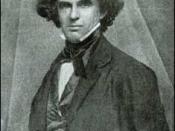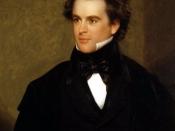'The Minister's Black Veil', a literary masterpiece written by Nathaniel Hawthorne, was a divergent parable for the period it was written. Nathaniel Hawthorne wrote as an anti-transcendentalist in the transcendentalist period; as a result, his view's in writings were mostly pessimistic considering his family's sinfulness. Hawthorne's grandfather was a judge in the Salem witch trails; for that reason, he was responsible for over twenty innocent deaths by mistrial. In addition, a reader can easily see the pessimism in his writing, and many hypothesize that his family's past has a part in his style. In the 'The Minister's Black Veil', Hawthorne shows a great deal of pessimism through a minister who feels that he is too sinful to show his face. The minister, Mr. Hopper, has many hidden sins; furthermore, hidden sins is the main theme of the parable.
Hawthorne develops the theme of hidden sins through his main character, Mr.
Hopper. Mr. Hopper, a minister, wears a black veil that resembles a man hiding his past sins. Many people do not understand or even accept the veil over his face. Hawthorne pictures the parson wearing the black veil and delivering his sermon along with a confused congregation including a elder woman who says, ''I don't like it,.....He has changed himself into something awful only by hiding his face''(294). Others cry, ''Our parson is going mad''(294)! The sermon in which he speaks that day is '...darker than usual...'(294), and also gives a gloomy feeling. The parson speaks of a secret sin; the audience soon relates the sermon to why he is wearing his black veil. The congregation feels that the sermon is given by someone else through Mr. Hopper's body. As a result, the minister's black veil is the talk of the town after the disturbing...



Thanks for the help
Your paper gave me a direction for writing my own.
3 out of 3 people found this comment useful.